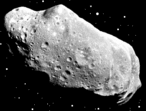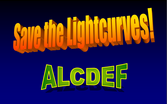This web site serves as a gateway to the Collaborative Asteroid Lightcurve Link (CALL) web site in addition to many other subsites, external sites, and pages that concern research on asteroids (the "minor planets").
Use the links to the left to navigate to the subsites
Updated 2025 July 20
What's New
The The Ephemeris Generator now covers oppositions from 2020 through 2035 and
includes minimum solar phase angle information (date, phase angle, declination).
The lists for yearly favorable apparitions and the five best apparitions for numbered numbered asteroids on the Observing Guides page have been significantly revised and improved.
The lists for yearly favorable apparitions and the five best apparitions for numbered numbered asteroids on the Observing Guides page have been significantly revised and improved.
Collaborative Asteroid Lightcurve Link (CALL)
The CALL web site provides pages to where you can "reserve" an asteroid for observation. This lets
other observers know that you are working it and either find another target or to request a
collaboration in order to gather more data sooner. You can also submit the results of your asteroid
lightcurve observations so that they are available to others prior to formal publication. The CALL
site includes subpages that provide lists of targets for upcoming and recent past 3-month periods
and other sites dedicated to asteroid lightcurve efforts.
Asteroid Lightcurve Database (LCDB) 2023 October Release #2
The asteroid lightcurve database (LCDB; Warner et al., 2009, Icarus 202, 134-146) is a compilation of
published results that now includes period/amplitude parameters for more than 8,000 asteroids. In addition
to a ZIP file download that contains pre-generated files, the LCDB pages include a query page where you
can generate custom reports.
The latest release (2023 October) of the LCDB is now available. The underlying SQL tables used throughout this site have also been updated.
Important Notice: There are several significant changes starting in the 2020 March release. Please read the readme.pdf that is included in the ZIP file.
In addition, there are column mapping changes for the summary and details tables following the separation of G and G1G2, i.e., some papers give both H-G and H-G1(G2). The changes allow all three values to be recorded. N.B. The LCDB does not distiguish betweeh H-G12 and H-G1G2.
The latest release (2023 October) of the LCDB is now available. The underlying SQL tables used throughout this site have also been updated.
Important Notice: There are several significant changes starting in the 2020 March release. Please read the readme.pdf that is included in the ZIP file.
In addition, there are column mapping changes for the summary and details tables following the separation of G and G1G2, i.e., some papers give both H-G and H-G1(G2). The changes allow all three values to be recorded. N.B. The LCDB does not distiguish betweeh H-G12 and H-G1G2.
The Minor Planet Bulletin
Get the latest issue of the Minor Planet Bulletin
as well as all past issues.
The Minor Planet Bulletin is the journal for amateurs (and even professionals) to publish individual lightcurves (one at a time or in bulk). The MPB is indexed by the ADS and found in the libraries of major observatories and institutions around the world. From the early 2000s until 2015, the MPB published the vast majority of new asteroid lightcurves. Some wide field surveys in the last few years have published large numbers of lightcurves based on sparse data sets but the MPB is still where the majority of dense time-series photometry results are published.
The MPB has its own domain and home page at https://mpbulletin.org. Complete issues from MPB 1-1 to present are now available. The titles, authors, and (optionally) abstracts for the papers for a selected issue are displayed to make browsing through past issues easier.
MPB AuthorsDownload the latest MPB templates and Authors Guide (3.1)
The Minor Planet Bulletin is the journal for amateurs (and even professionals) to publish individual lightcurves (one at a time or in bulk). The MPB is indexed by the ADS and found in the libraries of major observatories and institutions around the world. From the early 2000s until 2015, the MPB published the vast majority of new asteroid lightcurves. Some wide field surveys in the last few years have published large numbers of lightcurves based on sparse data sets but the MPB is still where the majority of dense time-series photometry results are published.
The MPB has its own domain and home page at https://mpbulletin.org. Complete issues from MPB 1-1 to present are now available. The titles, authors, and (optionally) abstracts for the papers for a selected issue are displayed to make browsing through past issues easier.
MPB AuthorsDownload the latest MPB templates and Authors Guide (3.1)
ALCDEF Verify
ALCDEFVerify is now a web-based program
for those writing scripts or programs to generate ALCDEF
files from their data. The ALCDEF home page has a link to the latest documentation, including the new "Constant
Keywords" concept used to safe storage space.
Expanded Features on Observing Planning Tools
The Ephemeris Generator and One Asteroid tools (available via the Observation Planning page) now
use a single oppositions data table that covers from 2020-2035. This allows you to plan further into
the future. The table will be updated around the first of each year, removing the oldest data and
extending out another year.
Asteroid Appulse Data (2024-2026)
Five Favorable/Brightest Apparitions (Numbered Asteroids)
The Observing Guides page has links to the latest
files, which cover numbered asteroids from 1 to 811552.


